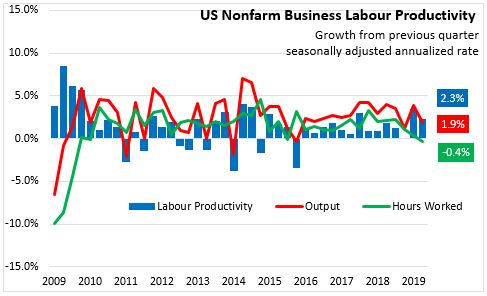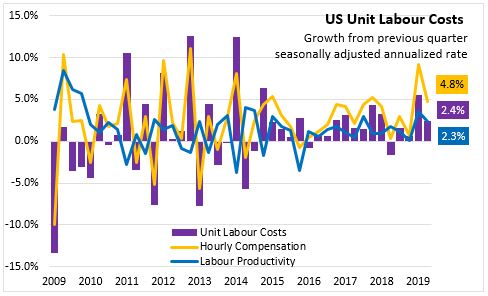The Economics and Statistics Division maintains archives of previous publications for accountability purposes, but makes no updates to keep these documents current with the latest data revisions from Statistics Canada. As a result, information in older documents may not be accurate. Please exercise caution when referring to older documents. For the latest information and historical data, please contact the individual listed to the right.
<--- Return to Archive
For additional information relating to this article, please contact:
August 15, 2019US PRODUCTIVITY, SECOND QUARTER 2019 The US Bureau of Labor Statistics has released preliminary productivity estimates for the second quarter of 2019. All figures are reported as growth from the previous quarter at seasonally adjusted annualized rates.

Nonfarm business sector labour productivity in the US increased 2.3 per cent in the second quarter of 2019, following an increase of 3.5 per cent in the first quarter of 2019. Output increased 1.9 per cent and hours worked decreased 0.4 per cent.
US unit labour costs increased 2.4 per cent as hourly compensation rose faster than labour productivity.

Manufacturing sector labour productivity decreased 1.6 per cent in the second quarter as output decreased 2.1 per cent and hours worked decreased 0.5 per cent. Productivity decreased 0.9 per cent for durable goods and decreased 2.6 per cent for non-durable goods. Unit labour costs rose 5.8 per cent in US manufacturing in Q2.
Notes: labour productivity, or output per hour, is calculated by dividing an index of real output by an index of hours worked by all persons, including employees, proprietors, and unpaid family workers. Unit labour costs are calculated as the ratio of hourly compensation to labour productivity; increases in hourly compensation increase unit labour costs while increases in productivity (output per hour) reduce unit labour costs. US manufacturing output is calculated on a different basis than for all nonfarm businesses, so these series are not directly comparable.
Source: US Bureau of Labor Statistics
<--- Return to Archive